Biomerieux Vidas User manual
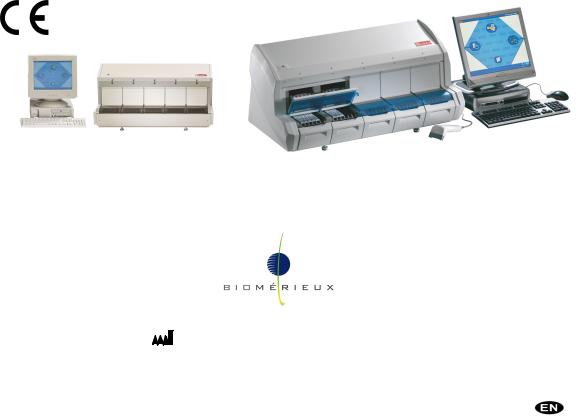
Ref : 99762
Version B
12/2005
VIDAS®
Instrument User’s Manual

 bioMérieux® SA 69280 Marcy l'Etoile / France
bioMérieux® SA 69280 Marcy l'Etoile / France
Tel. 33 (0)4 78 87 20 00 - Fax 33 (0)4 78 87 20 90
http://www.biomerieux.com
Printed in France / 673 620 399 RCS Lyon © 2005. bioMerieux, SA
V.AG 06.2005 en
Argentina
bioMérieux Argentina
Av. Congreso 1745 (C1428BUE) Capital Federal Buenos Aires
tel. (54) 11 5555-6800 fax (54) 11 5555-6888
Australia
bioMérieux Australia P/L
Unit 25, Parkview Business Center 1 Maitland Place
Baulkham Hills NSW 2153 tel. (61) 2 8852 4700
fax (61) 2 8852 4777
Austria
bioMérieux Austria GmbH
Eduard-Kittenberger-Gasse 97 Top 3
A-1230 Wien
tel. (43) 186 50 650 fax (43) 186 50 661
Belgium
bioMérieux Benelux s.a./n.v.
Media Square
18-19 Place des Carabiniers Bruxelles 1030
tel. (32) 2 743 01 70 fax (32) 2 733 55 97
Brazil
bioMérieux Brasil SA
Estrada Do Mapua
491 Taquara - Jacarepaguá
CEP 22710 261 Rio de Janeiro R.J Rio de Janeiro R.J
tel. (55) 21 2444 1400 fax (55) 21 2455 6025
Canada
bioMérieux Canada, Inc.
7815, Henri-Bourassa West Saint Laurent, QC
H4S 1P7
tel. (1) 514 336 7321 fax (1) 514 807 0015
Chile
bioMérieux Chile S.A.
Seminario 131 Providencia Santiago
tel. (56) 2634 20 92 fax (56) 2634 20 93
China
bioMérieux China Limited
17/Floor, Yen Sheng Centre, 64 Hoi Yuen Road,
Kwun Tong
Kowloon - Hong Kong tel. (852) 2356 7033 fax (852) 2330 2085
Colombia
bioMérieux Colombia Ltda
Avenida 15 No. 100-43 Piso 2
Bogotá D.C.
tel. (57) 1 520 0080
fax (57) 1 520 0088 / 1 520 0831
Denmark
bioMérieux Danmark Aps
Smedeholm 13C, 2730 Herlev
tel. (45) 70 10 84 00 fax (45) 70 10 84 01
Finland
bioMérieux Suomi Oy
Rajatorpantie 41 C 01640 Vantaa
tel. (358) 9 8545 6000 fax (358) 9 8545 6045
France
bioMérieux SA
69280 Marcy l’Etoile tel. 33 (0)4 78 87 20 00 fax 33 (0)4 78 87 20 90
http://www.biomerieux.com
Germany
bioMérieux Deutschland GmbH
Weberstrasse 8 D-72622 Nürtingen tel. (49) 7022 30070 fax (49) 7022 36110
Greece
bioMérieux Hellas S.A.
Papanikoli 70
15232 Halandri Athens
tel. (30) 210 81 72 400 fax (30) 210 68 00 880
Hungary
Representation office bioMérieux B.V. Hungarian
Reitter Ferenc u. 39-49 1135 Budapest, Budapest
tel. (36) 1 412 3880 fax (36) 1 412 3890
India
bioMérieux India Pvt. Ltd
D-45, Defense Colony New Delhi 110 024
tel. (91) 11 2 464 88 40 fax (91) 11 2 464 88 30
Indonesia
bioMérieux Asean
Enseval Building
Kawasan Industri Pulo Gadung - JI. Pulo Lentut No. 10
Jakarta Timur 13920 tel. (62) 21 461 51 11 fax (62) 21 460 41 07
Italy
bioMérieux Italia S.p. A
Via Fiume Bianco, 56 00144 Roma
tel. (39) 06 52 308 1 fax (39) 06 52 308 240
Ivory Coast
bioMérieux Afrique Occidentale
08 BP 2634
Abidjan 08
tel. (225) 22 40 93 93 / 22 40 41 40 fax (225) 22 40 93 94
Japan
bioMérieux Japan, Ltd
Seizan Bldg.,
12-28 Kita-Ayoama 2-chome Minato-ku,
Tokyo 107-0061
tel. (81) 3 5411 86 91 fax (81) 3 5411 86 90
Korea
bioMérieux Korea Co., Ltd
7th Floor Yoosung Building
# 830-67, Yoksam-dong, Kangnam ku Seoul
tel. (82) 2 547 6262 fax (82) 2 547 6263
Mexico
bioMérieux México SA de CV
Chihuahua 88, col. Progreso México 01080, D.F.
tel. (52) 55 5481 9550 fax (52) 55 5616 2245
Netherlands (The) bioMérieux Benelux BV
Boseind 15
P.O. Box 23 5280 AA Boxtel
tel. (31) 411 65 48 88 fax (31) 411 65 48 73
New Zealand
bioMérieux New Zealand Ltd
22/10 Airbourne Road North Harbour Auckland
tel. (64) 9 415 0601 fax (64) 9 415 0603
Norway
bioMérieux Norge AS
kernveien 145 N - 0513 Oslo
tel. (47) 23 37 55 50 fax (47) 23 37 55 51
Philippines (The)
Representation office
bioMérieux Philippines Rep. Office 11th Floor, Pearlbank Centre
146 Valero Street, Salcedo Village
1227 Makati City tel. (632) 817 7741 fax (632) 812 0896
Poland
bioMérieux Polska Sp. Z.o.o. ul. Zeromskiego 17
01-882 Warszawa tel. (48) 22 569 85 00 fax (48) 22 569 85 54
Portugal
bioMérieux Portugal, Lda.
Rua Alto do Montijo,
Lotes 1 e 2 - Portela de Carnaxide 2794-070 Carnaxide
tel. (351) 21 424 59 80 fax (351) 21 418 32 67
Russia
o.o.o. bioMérieux
Petrovsko-Razoumovskii proyezd, 29 127287 Moscow
tel. (7) 095 212 10 26 / 095 424 79 38 fax (7) 095 214 95 41
Spain
bioMérieux España S.A.
Manual Tovar, 45-47 28034 Madrid
tel. (34) 91 358 11 42 fax (34) 91 358 06 29
Sweden
bioMérieux Sverige AB
Hantverksvägen 15 436 33 Askim
tel. (46) 31 68 84 90 fax (46) 31 68 48 48
Switzerland bioMérieux Suisse s.a.
51, avenue Blanc Case postale 2150 1211 Genève 2
tel. (41) 22 906 57 60 fax (41) 22 906 57 42
Taiwan
Representation office
bioMérieux China Limited - Taiwan Branch
RM 608, No. 6-3 Ching Cheng Street Taipei 105
tel. (886) 2 2545 2250 fax (886) 2 2545 0959
Thaïland
bioMérieux Thaïland Ltd
Regent House Bldg, 16 th Floor
183 Rajdamri Road, Lumpini, Pathumwan Bangkok 10330
tel. (66) 2 651 98 00 fax (66) 2 651 98 01
Distribution in over 130 countries
Turkey
bioMérieux Diagnostik A.S.
Değirmen Sok. Nida Plaza Kat:6 34742 Kozyataği / Istanbul
tel. (90) 216 444 00 83 fax (90) 216 373 16 63
United Kingdom bioMérieux UK Ltd
Grafton Way, Basingstoke Hampshire RG22 6HY tel. (44) 1256 461881
fax (44) 1256 816863
USA bioMérieux, Inc.
100 Rodolphe Street Durham NC 27712 tel. (1) 919 620 20 00 fax (1) 919 620 22 11
Vietnam
Representation office bioMérieux Vietnam Rep. Office
17 Nguyen Van Mai, Ward 8 District 3
Ho Chi Minh City tel. (84) 88 299 599 fax (84) 88 207 898

V.B 02/2005
This manual is periodically updated. The updates shall be included in the new releases of the Software.
Information supplied in this manual may be subject to modifications before the products described become available.
This manual may contain information or references relating to certain bioMérieux® SA products, software or services which are not available in the country of release; this shall not mean that bioMérieux SA intends to market such products, software or services in such country
To request copies of publications or for any technical request, contact bioMérieux SA or your local distributor.
L i a b i l i t y d i s c l a i m e r
This manual is provided “AS IS” without any warranty, whether express or implied, of merchantability, safety, quality, accuracy, performance of products described on this manual, including an implied warranty of merchantability or fitness for a particular purpose, non infringement of third parties intellectual property rights and against an incidental or direct damage.
In no event shall bioMérieux SA be liable for any direct or indirect damage or consequence related to, arising out of or in connection with, any use of this manual and/or its results by the User and/or any third party.
In no event shall this manual be construed as an undertaking of bioMérieux SA, who reserves the right to modify this manual without notice and shall incur no liability as a result of such modification.
This manual is provided for information purposes only and except for the present provisions does not constitute a binding document legally.
I n t e l l e c t u a l P r o p e r t y
bioMérieux SA is the sole owner of copyright, patrimonial rights and any other intellectual property rights in and to this manual and its content subject to possible third parties rights.
This manual and its content are protected under the provisions of section L.111-1 and following articles of the French Intellectual Property Code and International Copyright and Author Rights Treaties.
The rights to use this manual granted herein are non-exclusive and limited to the extent necessary to use the Software and Instrument. In no event shall the Users be granted herein any other right to use this manual including without limitation, the right to reproduce, represent, adapt or translate all or part of this manual by any mean whatsoever and in any country without the prior written consent of bioMérieux SA.
Any use of this manual other than expressly permitted hereunder shall be prosecuted.
IMPORTANT! USE OF THIS MANUAL CONSTITUTES ACCEPTANCE OF THE CLAUSES ABOVE MENTIONED.
bioMérieux, the blue logo and VIDAS are used, pending and/or registered trademarks belonging to bioMérieux SA or one of its subsidiaries.
Windows is a used, pending and/or registered trademark belonging to Microsoft Corporation. Dacron is a used, pending and/or registered trademark belonging to Invista North America, SARL. 7X is a used, pending and/or registered trademark belonging to MP Biomedicals, LLC.
Alconox and Liquinox are used, pending and/or registered trademarks belonging to Alconox, Inc.
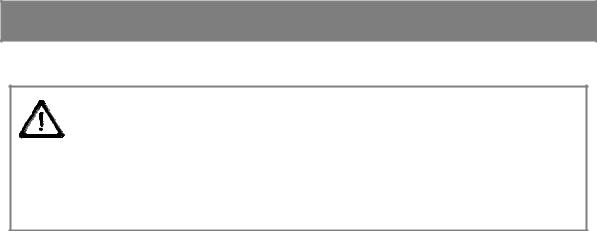
V.B 02/2005
General Warnings
DANGER! |
All biological fluids should be considered as potentially infectious. |
Protective gloves must be worn when manipulating blood, products derived from blood or objects contaminated with blood.
Qualified laboratory personnel should use acceptable procedures for biohazardous material.
IMPORTANT! The configuration that you have purchased is adapted to the legislation and standards of the different countries it will be sent to.
For this reason, it may differ from the one presented in this document. However, it will not prevent VIDAS® from operating correctly.
This product is an in vitro diagnostic medical device. It complies with the directives and standards mentioned in the certificate supplied with it.
The user is advised to read and understand all instructions in this manual to be able to derive the best performance from the VIDAS.
bioMérieux SA recommends that you observe the different warnings inscribed on the instrument itself and indicated in the documentation supplied.
The accuracy of results obtained with this instrument depends, in particular, on the maintenance operations described in this manual.
The user should be aware that, if the maintenance operations are not performed, are only partially performed, or are not performed as described in this manual, bioMérieux SA is in no case liable for any false test results obtained.
bioMérieux SA is in no case liable for any changes made to the equipment without authorization from bioMérieux SA.

IMPORTANT! |
Electromagnetic Compatibility (EMC): |
|
|
This is a Class A product. |
|
|
In a residential area, this product may cause harmful interference in which |
|
|
case the user may be required to take adequate measures at his own |
|
|
expense. |
|
|
The equipment may also cause inteference if not installed in accordance |
|
|
with the instructions given in this manual. |
|
|
This statement only applies to European countries and instruments |
|
|
bearing the |
symbol with regard to the waste electrical and electronic |
equipment European directive.
You can play an important role in contributing to reuse, recycling and other forms of recovery of waste electrical and electronic equipment. Sorting this type of waste significantly reduces potential negative effects on the environment and human health as a result of the presence of hazardous substances in electrical and electronic equipment.
At the end of the life cycle of this product, do not dispose of the product as unsorted municipal waste, even if it is decontaminated. It is imperative that you contact bioMérieux to assure for its appropriate disposal.

Revisions
The list of revisions below summarizes replacements or additional pages in your
VIDAS Instrument User’s Manual.
Manual |
Reason |
Page(s) |
|
|
|
V.A 03.2005 |
New VIDAS model |
All |
|
|
|
V.B 12.2005 |
New software version |
All |
|
|
|
VIDAS® Instrument User's manual |
Revisions-1 |

Table of Contents
1 How to use this manual |
1-1 |
|
|
Finding topics and procedures............................................................................................................. |
1-2 |
|
Typographic conventions ..................................................................................................................... |
1-3 |
|
Warnings.............................................................................................................................................. |
1-3 |
|
Graphic symbols .................................................................................................................................. |
1-4 |
2 |
Functional description |
2-1 |
|
Description / aim .................................................................................................................................. |
2-3 |
|
Configuration components ................................................................................................................... |
2-4 |
|
Hardware........................................................................................................................................ |
2-6 |
|
Extension potential ....................................................................................................................... |
2-11 |
|
Consumables ............................................................................................................................... |
2-12 |
|
General features and technical specifications.................................................................................... |
2-17 |
|
Environmental conditions ............................................................................................................. |
2-17 |
|
Physical features.......................................................................................................................... |
2-18 |
|
Electrical specifications ................................................................................................................ |
2-19 |
|
Technical specifications ............................................................................................................... |
2-20 |
|
Temperature control ..................................................................................................................... |
2-20 |
|
Characteristics of optical components.......................................................................................... |
2-21 |
|
Assay kit....................................................................................................................................... |
2-21 |
|
Operating principles ........................................................................................................................... |
2-22 |
|
Immunoassay methods ................................................................................................................ |
2-22 |
|
Protocol concept........................................................................................................................... |
2-23 |
|
Optical system.............................................................................................................................. |
2-25 |
|
Performance checks / self-tests......................................................................................................... |
2-26 |
|
Optical system.............................................................................................................................. |
2-26 |
|
Pipette mechanisms ..................................................................................................................... |
2-28 |
|
VIDAS temperature ...................................................................................................................... |
2-28 |
3 |
Getting started |
3-1 |
|
Recommendations for installation and use .......................................................................................... |
3-2 |
|
Unpacking the VIDAS .......................................................................................................................... |
3-4 |
|
Assembly and installation .................................................................................................................... |
3-5 |
|
Choosing a location........................................................................................................................ |
3-6 |
4 |
Starting the VIDAS |
4-1 |
|
Switching on......................................................................................................................................... |
4-2 |
|
Installing the hand-held bar code reader.............................................................................................. |
4-3 |
|
Preliminary instructions .................................................................................................................. |
4-3 |
|
Preparing the computer.................................................................................................................. |
4-4 |
|
|
|
VIDAS® Instrument User's manual |
V-1 |
|

Table of Contents
|
Preparing the reader ...................................................................................................................... |
4-8 |
|
Connecting the bar code reader ..................................................................................................... |
4-8 |
|
Configuring the bar code reader................................................................................................... |
4-10 |
|
Recommendation for use of the bar code reader ......................................................................... |
4-11 |
5 |
Using VIDAS |
5-1 |
|
Basic VIDAS work flow......................................................................................................................... |
5-2 |
6 |
Maintenance |
6-1 |
|
Preventive maintenance....................................................................................................................... |
6-2 |
|
User maintenance................................................................................................................................ |
6-3 |
|
Tools required ................................................................................................................................ |
6-3 |
|
Summary of maintenance operations................................................................................................... |
6-4 |
|
Decontamination of the VIDAS blue..................................................................................................... |
6-5 |
|
Cleaning the strip preparation tray ................................................................................................. |
6-8 |
|
Cleaning the reagent strip trays.................................................................................................... |
6-10 |
|
Cleaning the spill tray ................................................................................................................... |
6-12 |
|
Reassembling the strip preparation tray and switching the analytical |
|
|
module back on ............................................................................................................................ |
6-13 |
|
Using the reagent for testing the pipette mechanisms: Quality Control VIDAS |
|
|
(QCV) – Reference 30706 ................................................................................................................. |
6-13 |
|
Decontamination of the VIDAS .......................................................................................................... |
6-14 |
|
Cleaning the SPR® block.............................................................................................................. |
6-15 |
|
Cleaning the reagent strip trays.................................................................................................... |
6-17 |
|
Cleaning the spill tray ................................................................................................................... |
6-18 |
|
Replacing the front panel and switching the analytical module back on....................................... |
6-19 |
|
Using the reagent for testing the pipette mechanisms: Quality Control VIDAS |
|
|
(QCV) – Reference 30706 ................................................................................................................. |
6-19 |
|
Computer ........................................................................................................................................... |
6-20 |
|
Cleaning the screen ..................................................................................................................... |
6-20 |
|
Printer ................................................................................................................................................ |
6-22 |
|
Cleaning ....................................................................................................................................... |
6-22 |
|
Replacing the ink cartridge ........................................................................................................... |
6-22 |
|
Bar code reader ................................................................................................................................. |
6-22 |
|
Cleaning ....................................................................................................................................... |
6-22 |
7 |
Troubleshooting |
7-1 |
8 |
Glossary |
8-1 |
9 |
Index |
9-1 |
Notes
V-2 |
VIDAS® Instrument User's manual |

List of figures
Functional description
Fig. 2-1: VIDAS configuration .................................................................................................................... |
2-2 |
Fig. 2-2: Configuration components (example).......................................................................................... |
2-4 |
Fig. 2-3: Reagent strip tray ........................................................................................................................ |
2-7 |
Fig. 2-4: Strip preparation tray closed........................................................................................................ |
2-8 |
Fig. 2-5: Opening the strip preparation tray ............................................................................................... |
2-8 |
Fig. 2-6: Reagent strips place on the strip preparation tray ....................................................................... |
2-8 |
Fig. 2-7: Reagent strips placed on the strip preparation tray with its boat ................................................. |
2-8 |
Fig. 2-8: SPR® block.................................................................................................................................. |
2-9 |
Fig. 2-9: Optical cuvette on a reagent strip.............................................................................................. |
2-10 |
Fig. 2-10: Single reagent strip.................................................................................................................. |
2-12 |
Fig. 2-11: Dual reagent strip .................................................................................................................... |
2-13 |
Fig. 2-12: Reagent strip label................................................................................................................... |
2-14 |
Fig. 2-13: Reagent strip dot ..................................................................................................................... |
2-14 |
Fig. 2-14: SPR® ....................................................................................................................................... |
2-16 |
Fig. 2-15: Dynamic reactions ................................................................................................................... |
2-23 |
Fig. 2-16: Example of a protocol.............................................................................................................. |
2-24 |
Fig. 2-17: Fluorescent reading................................................................................................................. |
2-25 |
Getting started
Fig. 3-1: Gripping area (only concerns VIDAS blue) .................................................................................. |
3-4 |
Starting the VIDAS
Fig. 4-1: Power switch ............................................................................................................................... |
4-2 |
|
Fig. 4-2 : Configuration options.................................................................................................................. |
4-4 |
|
Fig. 4-3 |
: Configuration details................................................................................................................... |
4-5 |
Fig. 4-4 |
: Shutting down Windows® ........................................................................................................... |
4-7 |
Fig. 4-5 |
: Shutting down the computer....................................................................................................... |
4-7 |
Fig. 4-6 |
: Example of a reader configuration sheet .................................................................................. |
4-10 |
Using VIDAS
Fig. 5-1: Basic VIDAS work flow ................................................................................................................ |
5-2 |
Fig. 5-2: Basic VIDAS work flow (cont'd)................................................................................................... |
5-3 |
|
|
VIDAS® Instrument User's manual |
VI-1 |

List of figures
Maintenance
Fig. 6-1: Opening the section fully ............................................................................................................. |
6-6 |
|
Fig. 6-2: Cleaning the SPR® block ............................................................................................................. |
6-7 |
|
Fig. 6-3: Cleaning the rear of the SPR® block............................................................................................ |
6-7 |
|
Fig. 6-4: Do not clean the seals situated above the SPR® block ............................................................... |
6-8 |
|
Fig. 6-5: Opening the strip preparation tray ............................................................................................... |
6-8 |
|
Fig. 6-6: Cleaning the strip preparation tray............................................................................................... |
6-9 |
|
Fig. 6-7: Dismantling the strip preparation tray ........................................................................................ |
6-10 |
|
Fig. 6-8: Removing the strip preparation tray........................................................................................... |
6-10 |
|
Fig. 6-9: Repositioning the strip sections trays ........................................................................................ |
6-11 |
|
Fig. 6-10: Cleaning the spill tray .............................................................................................................. |
6-12 |
|
Fig. 6-11: Removing the front panel......................................................................................................... |
6-14 |
|
Fig. 6-12: Cleaning the SPR® block ......................................................................................................... |
6-15 |
|
Fig. 6-13: Cleaning the rear of the SPR® block........................................................................................ |
6-16 |
|
Fig. 6-14: Do not clean the seals situated above the SPR® block............................................................ |
6-16 |
|
Fig. 6-15: Repositioning the strip sections trays ...................................................................................... |
6-17 |
|
Fig. 6-16: Cleaning the spill tray .............................................................................................................. |
6-18 |
|
Fig. 6-17: Replacing the front panel......................................................................................................... |
6-19 |
|
Fig. 6-18: Shutting down Windows®......................................................................................................... |
6-20 |
|
Fig. 6-19: Shutting down the computer .................................................................................................... |
6-21 |
|
Note: |
Software screens and figures are given for information purposes only. |
|
V-2 |
VIDAS® Instrument User's manual |

1 How to use this manual
I n t r o d u c t i o n
|
This manual deals exclusively with the VIDAS equipment and consumables. |
|
The software and procedures for use are described in the VIDAS PC User's |
|
Manual. |
|
The table of contents lists all the chapters of this manual. Each chapter is |
|
subdivided into sections corresponding to a procedure or a precise description. |
|
Answers to questions can easily be found by referring to the table of contents, or |
|
the index at the back of this manual. |
WARNING! |
The user is advised to read and understand all instructions in this manual |
|
to be able to derive the best performance from the VIDAS. |
VIDAS® Instrument User's manual |
1-1 |

How to use this manual
Finding topics and procedures
F i n d i n g t o p i c s a n d p r o c e d u r e s
|
This manual is divided into nine chapters. The first seven chapters are used for |
|
the description and procedures. Chapter 8 contains the glossary and chapter 9 |
|
the index. |
Table of contents |
The main table of contents of the manual is located on pages V-1 to V-2. |
|
It lists each chapter and the procedures and/or topics contained in the manual. |
List of figures |
Page VI-1 contains a list of the figures in this manual. |
Graphic symbols |
The standard symbols used for bioMérieux instruments, and their meanings, |
|
can be found in the list on page 1-4. |
Page headers and |
Apart from the first page of every chapter, each page of this manual includes a |
page footers |
page header and a footer. |
|
Each page header includes the chapter title and the title of a procedure or its |
|
corresponding description. |
|
These titles are located on the outside of the page so that you can thumb |
|
through the pages to quickly locate a chapter or a procedure. |
|
The footers contain the title of the manual, the name of the product and the |
|
page number. |
Glossary |
The glossary is located in chapter 8 at the back of the manual. It gives the |
|
definition of the main technical terms used in the manual. |
Index |
The index is located in chapter 9 at the back of the manual. It is used to locate a |
|
particular description or procedure. |
Sheet of |
One of these labels is applied to the equipment to certify that it has been |
decontamination |
properly decontaminated: |
labels |
− before any operation by a service technician, |
|
|
|
− before it is returned to the factory, if necessary. |
1-2 |
VIDAS® Instrument User's manual |
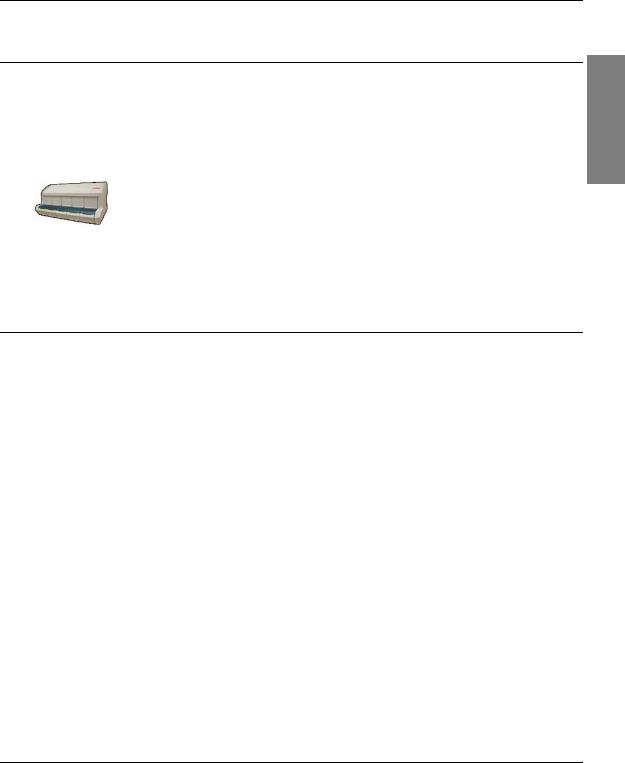
How to use this manual
Typographic conventions
T y p o g r a p h i c c o n v e n t i o n s
|
The following typographic conventions are used throughout this manual. |
|
1 |
• Prepare samples... |
The bullet point is used to indicate an action to be performed. |
|
This icon is used to indicate specific information concerning the VIDAS |
|
instrument called "VIDAS blue" in the manual. |
|
Unless otherwise specified, the information in the manual applies to the |
|
VIDAS, whichever model is used. |
W a r n i n g s
The following warnings are used throughout the manual:
−for safety reasons (DANGER!),
−to ensure that VIDAS is maintained in good working condition (CAUTION!),
−or to allow optimum use of your VIDAS (IMPORTANT! or WARNING!).
VIDAS® Instrument User's manual |
1-3 |
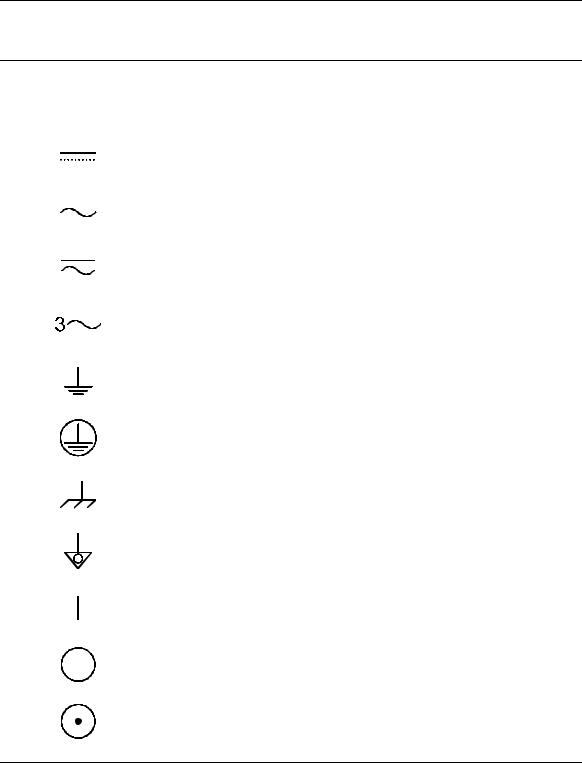
How to use this manual
Graphic symbols
G r a p h i c s y m b o l s
V.A 09/2003 – màj smn –10/2004
The standard symbols used for the bioMérieux systems and their meanings can be found below:
Direct current
Alternating current
Both direct and alternating current
Three-phase alternating current
Earth (ground) TERMINAL
PROTECTIVE CONDUCTOR TERMINAL
Frame or chassis TERMINAL
Equipotentiality
ON (power supply)
OFF (power supply)
"ON" (only for a component of the system equipment)
1-4 |
VIDAS® Instrument User's manual |
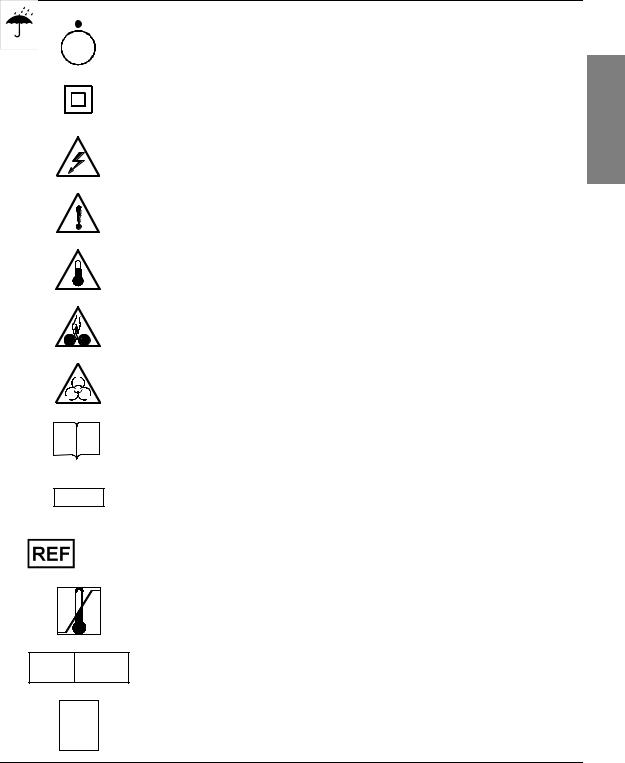
How to use this manual
Graphic symbols
|
"OFF" (only for a component of the system equipment) |
|
|
Equipment protected throughout by DOUBLE INSULATION or |
|
|
REINFORCED INSULATION (equivalent to Class II of IEC 536) |
1 |
|
|
|
|
Risk of electric shock |
|
|
Caution: see accompanying documents |
|
|
High temperature |
|
|
Potential pinch point |
|
|
Potential biohazard |
|
i |
Consult Instructions for Use |
|
LOT |
Batch code |
|
or REF |
Catalogue number |
|
|
|
|
|
Temperature limitation |
|
EC REP |
Authorised representative of the European Community |
|
|
Keep dry |
|
VIDAS® Instrument User's manual |
1-5 |
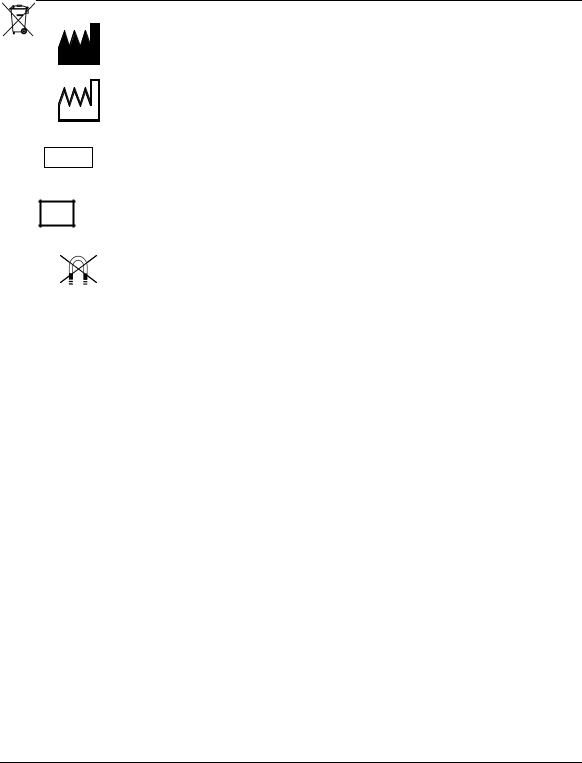
How to use this manual
Graphic symbols
|
Manufacturer |
|
Date of manufacture |
IVD |
In Vitro Diagnostic Medical Device |
SN or SN |
Serial number |
|
Keep away from magnetic field |
|
Separate collection for waste electrical and electronic equipment |
1-6 |
VIDAS® Instrument User's manual |

2 Functional description
I n t r o d u c t i o n
This chapter describes the VIDAS instrument:
−its configuration components,
−general features and technical specifications,
−operating principles,
−performance checks / self-tests.
VIDAS® Instrument User's manual |
2-1 |
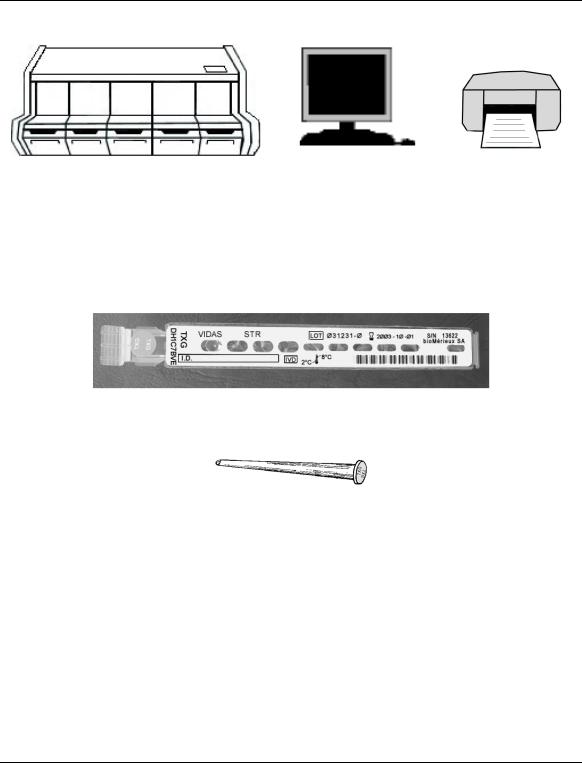
Functional description
Graphic symbols
Analytical module (example) |
Computer module (example) |
Reagent strip
SPR®
Fig. 2-1: VIDAS configuration
2-2 |
VIDAS® Instrument User's manual |

Functional description
Description / aim
D e s c r i p t i o n / a i m
VIDAS is a compact automated multiparametric immunoanalyzer including:
−the VIDAS analytical module divided into five independent sections each containing six assays with compatible protocols,
−the VIDAS PC software allowing up to two VIDAS modules to be operated,
−the reagents presented in kits of 60, 30 or 10 unit tests including :
−the SPR®s and reagent strips,
−the additional consumables required: standard, control(s), solvent,
−the factory calibration data provided in the form of a bar code (MLE card),
|
− the package insert. |
2 |
|
The basic VIDAS workflow steps consist of: |
|||
|
|||
• |
creating predefined sections, |
|
|
• performing calibrations and controls, |
|
||
• |
running assays. |
|
|
VIDAS offers routine batch or random access (mixed) testing for:
−serology,
−immunochemistry,
−antigen detection,
−industrial microbiology,
−immunohemostasis.
The combination of two original concepts, sectioned architecture and singledose reagents (SPR/Reagent Strip), offers:
−reliable results,
−ease-of-use,
−rapid analyis results.
VIDAS stands for: Vitek® Immuno Diagnostic Assay System.
The technology used, which is adaptable to a wide range of assays, combines the EIA method with a final fluorescence reading: this technology is known as ELFA (Enzyme Linked Fluorescent Assay).
The enzyme used in the VIDAS range is alkaline phosphatase.
The substrate is 4-methyl umbelliferyl phosphate (4-MUP) hydrolyzed into 4-methyl umbelliferone.
Umbelliferone fluoresces at 450 nm after excitation at 370 nm.
VIDAS® Instrument User's manual |
2-3 |
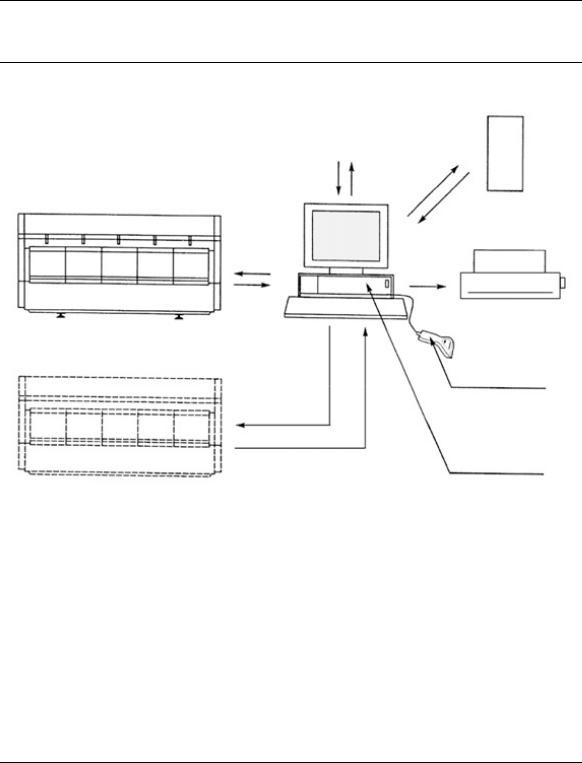
Functional description
Configuration components
C o n f i g u r a t i o n c o m p o n e n t s
Connection to external systems (optional)
UPS or laboratory safety power supply system (optional)
Printer
First analytical module
Bar code reader
- Monitor
- Computer
- Keyboard
- Mouse
Second analytical module (optional)
Fig. 2-2: Configuration components (example)
2-4 |
VIDAS® Instrument User's manual |

Functional description
Configuration components
The VIDAS can be divided into three categories of components :
−hardware,
−software,
−consumables.
Hardware |
VIDAS consists of: |
One or 2 analytical modules, each containing 5 sections of 6 positions each (capacity to process over 200 samples per day).
A computer system offering data management, result storage and bidirectional interface with the laboratory information system. This system consists of :
− |
a computer, |
2 |
|
−a screen,
−a bar code reader,
−a printer.
CAUTION! |
Never use material other than that specified by bioMérieux®. |
Software |
The software is multi-task and provides for: |
|
− entry of patient data and assays, |
|
− storage of calibrations in memory, |
|
− display and validation of results, |
|
− system operation and self-tests, |
|
− management of patient records, |
|
− management of the unior bidirectional interface (optional). |
IMPORTANT! |
Never download into the computer, programs other than those provided |
|
by bioMérieux. If these instructions are not complied with, the computer |
|
could become infected with computer viruses. Any intervention directly or |
|
indirectly resulting from the presence of such a virus cannot be covered |
|
by the warranty or the maintenance contract. |
Consumables |
Assay kit (60, 30 or 10 tests). |
VIDAS® Instrument User's manual |
2-5 |

Functional description
Configuration components
Hardware
Analytical module
General remarks 30 tests can be performed simultaneously: 5 sections (A, B, C, D, E) containing 6 positions each.
Each section is microprocessor-controlled and consists of:
−a transport tray for reagent strips,
−a pipetting system,
−a SPR® block for pipetting,
−an incubation system.
Each section operates independently, enabling the analytical module to handle a wide range of tests at one time.
An indicator light on each section shows the current status.
−The indicator light is on when a section is performing an assay.
−The indicator light flashes when the assays are completed.
−The indicator light goes off when the reagent strips and SPR®s are unloaded.
The VIDAS handles reagents via five six-channel pipetting systems (1 system per section) which carry out all reagent transfers, dilution and washing by means of the SPRs.
The pipetting system handles liquid volumes of between 8.9 µl to 316.5 µl. The system is lowered and raised to give the SPRs access to the wells on the reagent strip.
The six pipetting channels are physically independent but mechanically linked for synchronized operation.
Movement in each section is driven by stepper motors.
The range of movement is determined by parameter-defined protocols.
The assay temperature is 37°C inside the module.
Each module is equipped with two thermal probes per section, which ensure that this constant temperature is maintained.
2-6 |
VIDAS® Instrument User's manual |
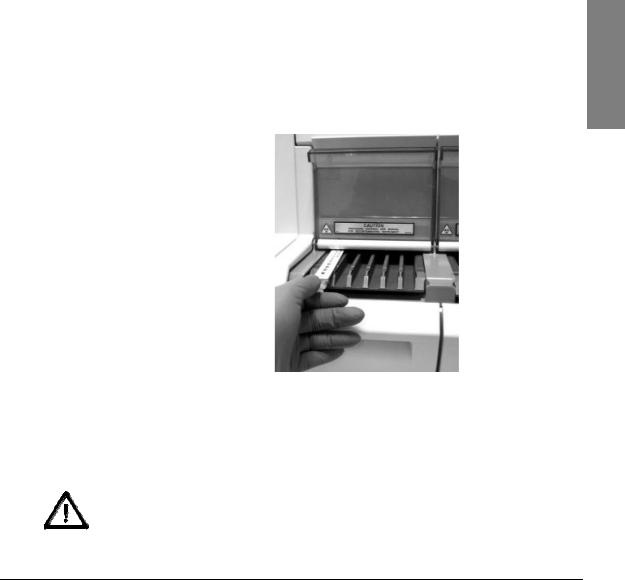
|
Functional description |
|
|
Configuration components |
|
|
|
|
Microprocessor |
In addition to the central processing unit, each VIDAS section contains its own |
|
|
microprocessor. |
|
|
Each microprocessor controls the movements required by each assay, |
|
|
depending on the protocol applying. |
|
|
Each section is therefore independent and autonomous. |
|
|
This unit is responsible for storing and operating assay protocols. |
|
|
A protocol consists of a series of commands including aspiration of the |
|
|
reagents, washing and optical scanning. |
|
|
The microprocessor enables the VIDAS to perform a fully automated assay. |
|
Reagent strip tray |
A plastic cover, located at the lower edge of each section, can be lifted up to |
|
|
reveal the reagent strip tray. |
|
|
This tray shown in the figure below contains six channels into which reagent |
2 |
|
strips can be inserted. |
Each channel constitutes a section position.
Up to six single reagent strips or three dual reagent strips can be inserted at one time, taking the total module capacity to 30 single tests.
Fig. 2-3: Reagent strip tray
The reagent strip tray is also used for automatic entry of the factory master calibration data (MLE card) using the card holder.
Note: |
For further information on the MLE card, see the VIDAS PC User's Manual. |
|
|
|
|
|
CAUTION! |
The reagent strip trays are movable parts. The risk of |
|
|
finger pinching exists. |
|
|
|
VIDAS® Instrument User's manual |
2-7 |
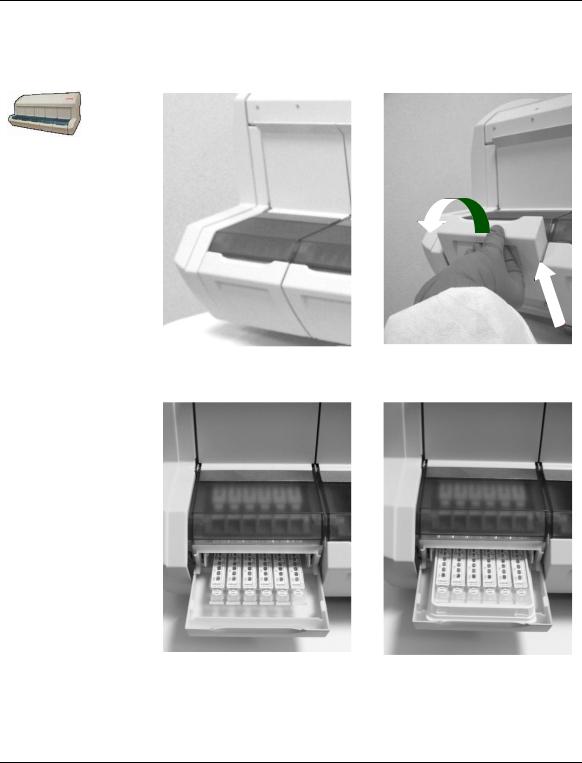
Functional description
Configuration components
Strip preparation tray A retractable strip preparation tray is located under each reagent strip tray.
(only concerns
VIDAS blue)
Fig. 2-4: Strip preparation tray closed
Fig. 2-5: Opening the strip preparation tray
Fig. 2-6: Reagent strips placed on |
Fig. 2-7: Reagent strips placed on |
the strip preparation tray |
the strip preparation tray with their |
|
boat |
2-8 |
VIDAS® Instrument User's manual |
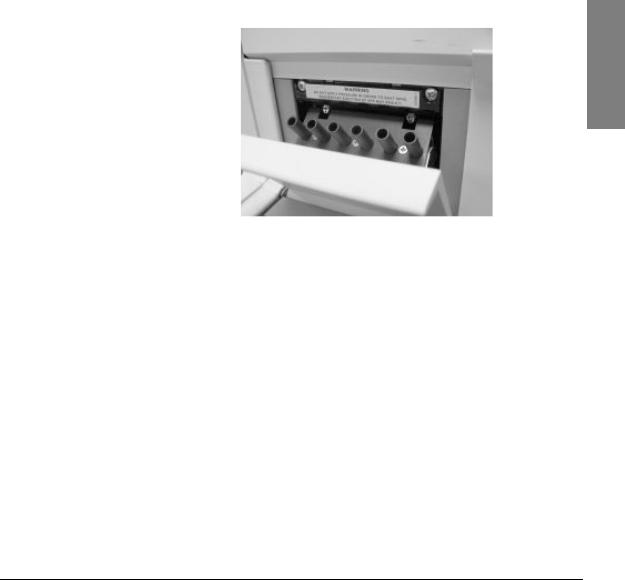
|
Functional description |
|
Configuration components |
|
|
SPR® block |
The upper part of the section includes a tilt-down door which gives access to |
|
the SPR block . |
|
The six positions of the SPR block correspond to the six positions of the reagent |
|
strip. |
|
During processing, the SPR block and SPRs form a pipetting device that is used |
|
throughout the assay. |
|
The reagent is cycled in and out of each SPR by a piston-driven air system. |
2
Fig. 2-8: SPR block
VIDAS® Instrument User's manual |
2-9 |
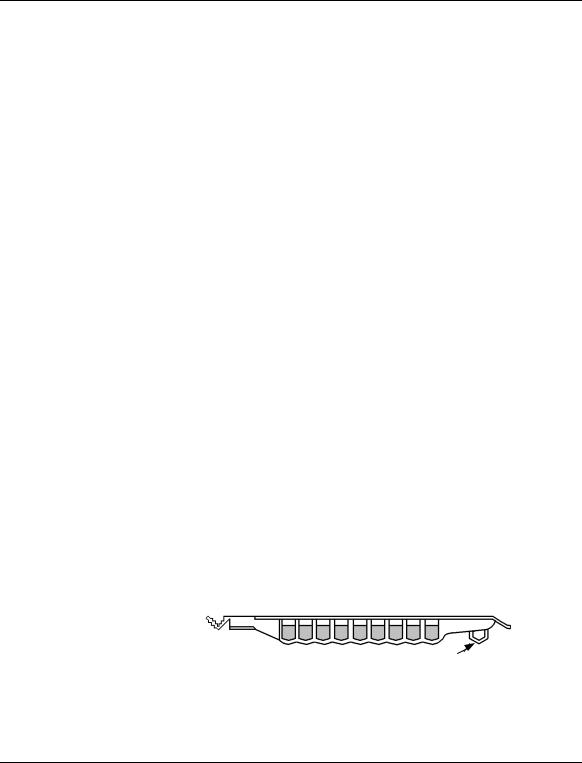
Functional description
Configuration components
Incubator |
Assays using the VIDAS require a controlled temperature. |
||
|
The temperature of each section tray and each SPR® block is individually |
||
|
controlled and monitored. |
||
|
Each tray and SPR block are equipped with a stable high-precision temperature |
||
|
detection system, known as the thermistor. |
||
|
During manufacture, each thermistor assembly is tested to NIST (National |
||
|
Institute of Standards and Technology) ITS-90 tolerance requirements for |
||
|
temperature measurement. |
||
|
The thermistors used in the VIDAS are accurate to within 0.2°C. |
||
|
Only thermistor systems that meet this criterion on manufacture are installed in |
||
|
the VIDAS. |
||
Note: |
To display the SPR block and tray temperatures, see the VIDAS PC User's Manual. |
||
Bar code readers |
Two bar code readers: |
||
|
− A hand-held bar code reader is included in the VIDAS configuration. It may |
||
|
be used to: |
||
|
− read the bar codes of certain reagents before they are used. The |
||
|
procedure for using these reagents is described in Chapter 5 of the |
||
|
VIDAS PC User’s Manual. |
||
|
− enter patient data or search for patient data (or a specimen) and read |
||
|
MLE cards. |
||
|
To install the hand-held bar code reader, see Chapter 4 "Installing the |
||
|
hand-held bar code reader". |
||
|
− An internal bar code reader enables identification of the reagent strips and |
||
|
reading of the MLE card. |
||
Detection system |
The VIDAS detection system consists of an optical fluorimetric scanner. |
||
|
It is mounted on a mechanical device which enables it to be used on all five |
||
|
sections. |
||
|
The system detects any chemical changes occurring in the optical cuvette at the |
||
|
end of each reagent strip. |
||
|
Fig. 2-9 shows the position of the optical cuvette on a standard reagent strip. |
||
|
|
|
|
|
|
|
|
Optical cuvette
Fig. 2-9: Optical cuvette on a reagent strip
2-10 |
VIDAS® Instrument User's manual |
